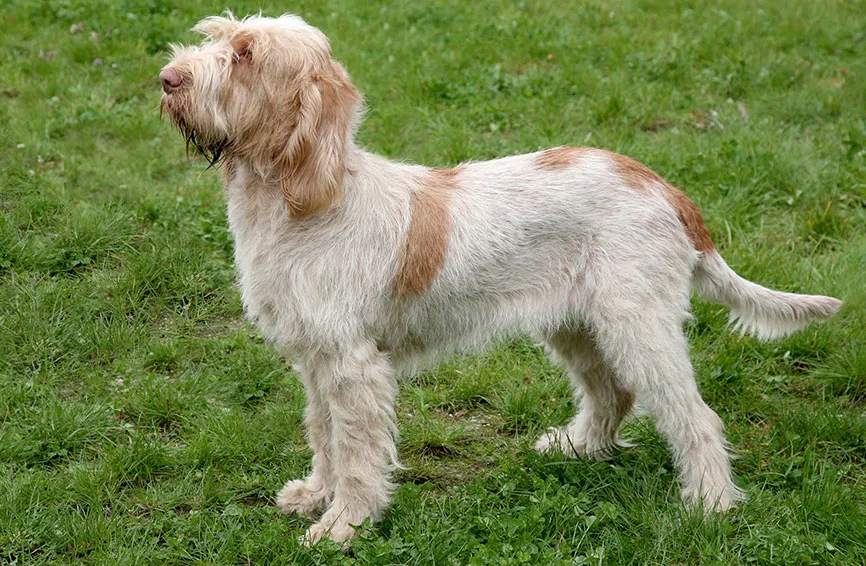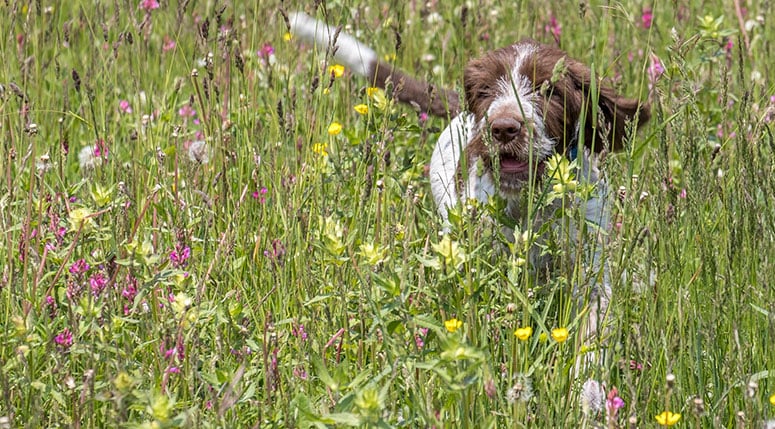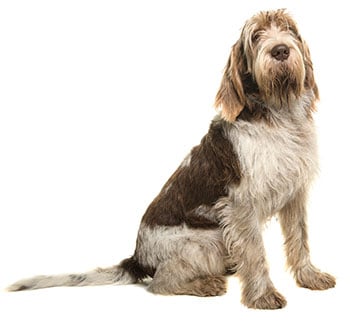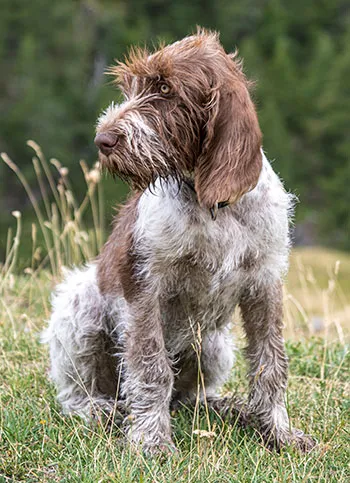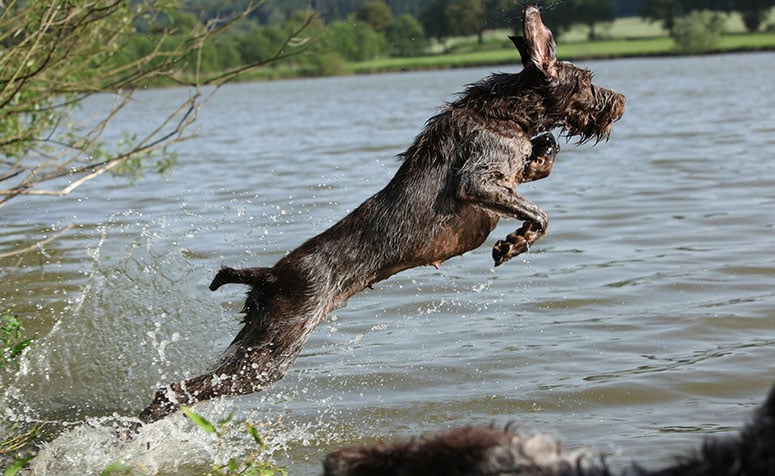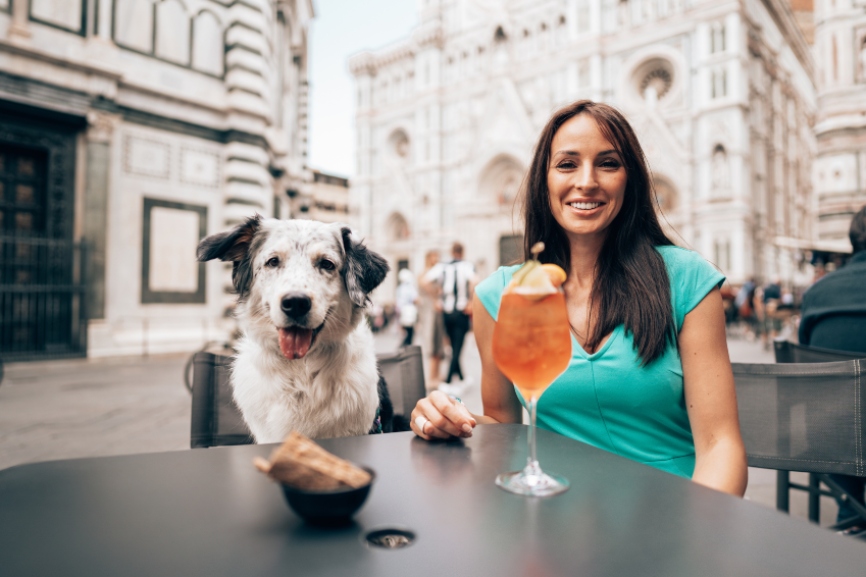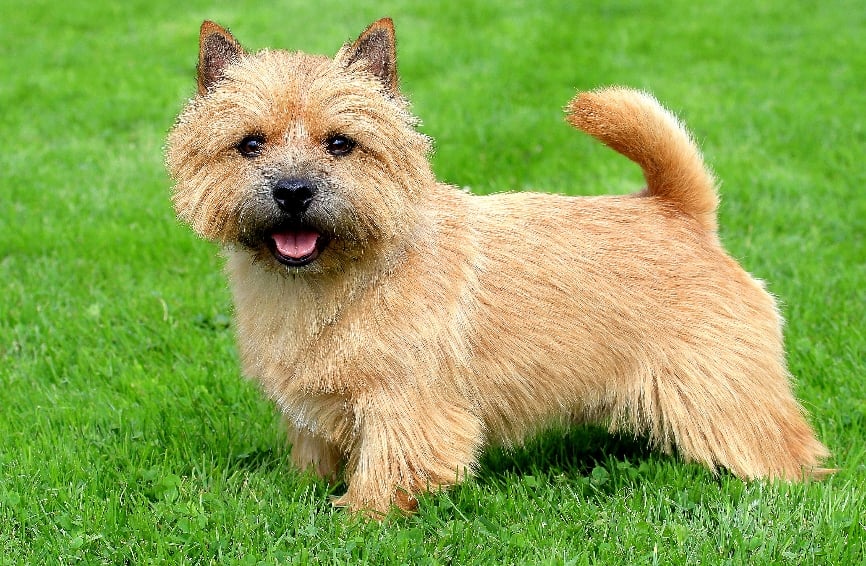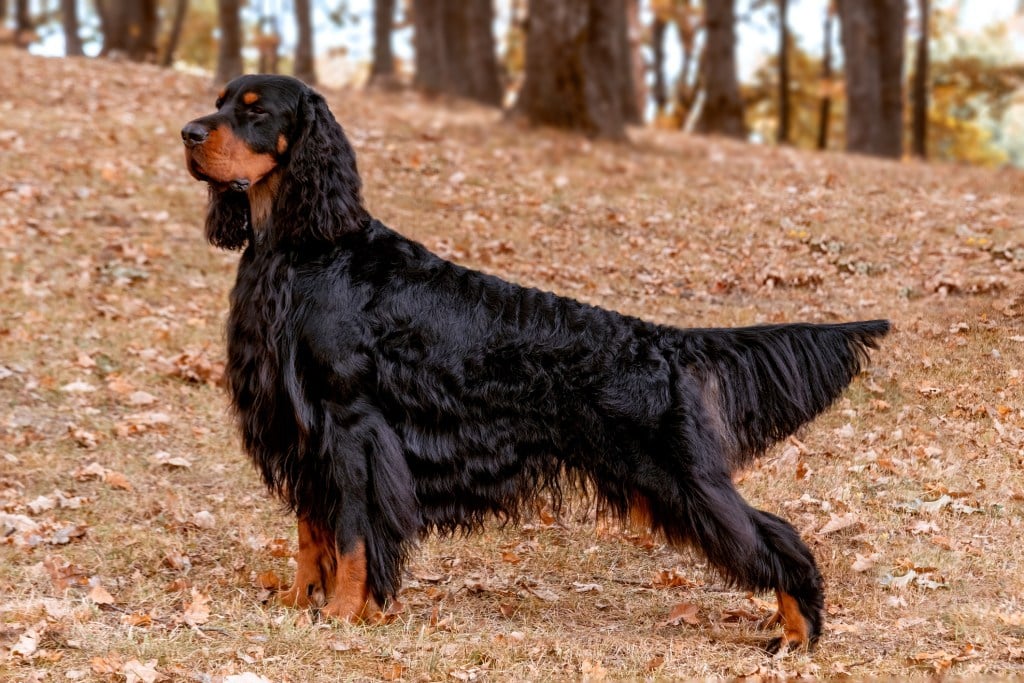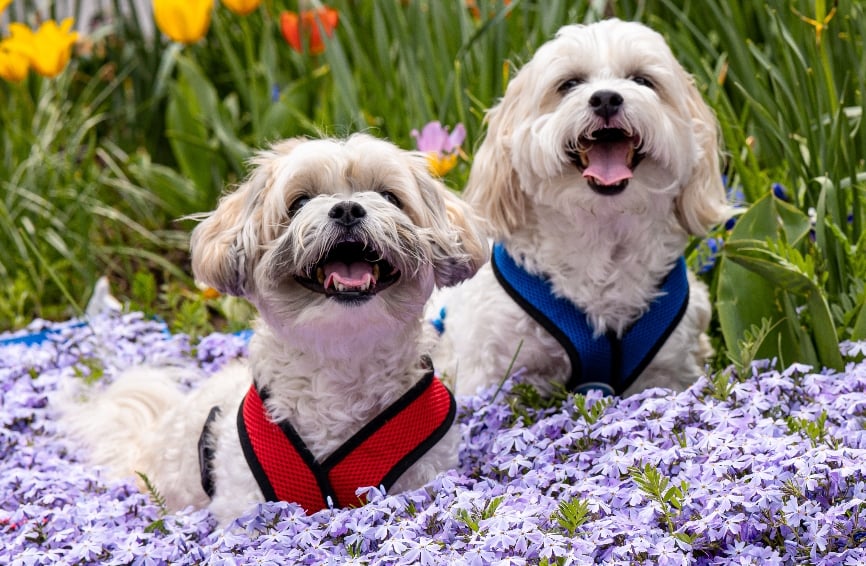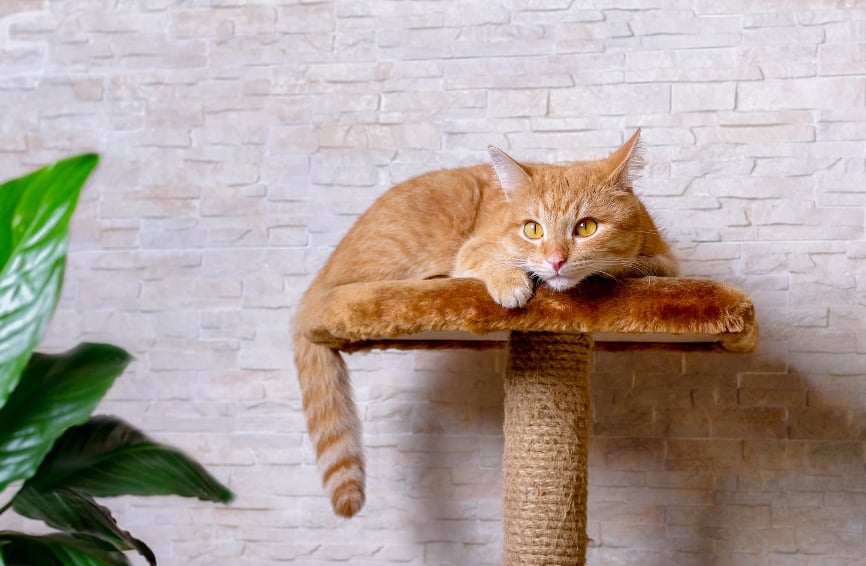Table of Contents
Introduction to Spinone Italianos
Spinone Italiano dogs are calm and friendly, with Italian lineage. These European field dogs are solid and built for endurance. There’s a certain old-world charm about spinone Italianos, and their sweet, expressive eyes might just win over your heart.
In this Healthy Paws breed guide, we cover everything you need to know about spinone Italianos, including the dogs’ size, temperament, care, health, and pet health insurance options.
Size of Spinone Italianos
Spinone Italianos stand 22 to 25 inches tall as adult females and 23 to 27 inches tall as adult males. The dogs’ weights are in direct proportion to the size and structure of the dogs. On average, they can weigh anywhere between 61 and 86 pounds when fully grown.
Here’s how big you can expect your spinone Italiano to get as the dog grows from puppyhood to adulthood:
| Weight Chart | 6 months | 12 months | 18 months |
| Average male spinone Italiano | 57.5 lbs. | 67.5 lbs. | 77 lbs. |
| Average female spinone Italiano | 50 lbs. | 55 lbs. | 66 lbs. |
Characteristics of Spinone Italianos
The medium/large spinone Italiano is athletic and an excellent companion for active families that are always on the go. They are versatile hunting dogs that are also loving and devoted family pets.
People love spinone Italianos because they are smart, patient, and great with kids. Their friendly temperaments and adaptable personalities make them easy to love and live with. Better yet, spinone Italianos respond well to training and have low-maintenance grooming needs.
As you get to know a spinone Italiano’s personality, here’s what you can expect based on the breed characteristics:
| Breed Characteristic | Level (High, Medium, Low) |
| Affectionate with People | High |
| Good with Kids | High |
| Good with Pets | High |
| Need for Exercise | Medium |
| Energy Level | Medium |
| Intelligence Level | High |
| Able to Be Trained | High |
| Amount of Barking | Low |
| Amount of Shedding | Medium |
History of Spinone Italianos
The spinone Italiano’s history dates back a long time, as this is a very old dog breed from continental Europe. They were bred as hunting dogs with excellent sniffing abilities and smart minds. On hunts, they are able to retrieve game on the land or in water, and they have great stamina to work all day and still be eager to please at the end of the day.
The breed’s name, “spinone,” refers to the thorny undergrowth from the Piedmont region of Italy. This reference directly relates to the dog’s work among the hills and alpine terrain of Italy while aiding its huntsmen. Historians believe the dogs were initially a cross of coarse-haired Italian setters, white mastiffs, French griffons, and other dogs accompanied by Greek traders and from the Adriatic coast. The breed has also been referred to as the Italian coarse-haired pointer.
In the late 1980s, the Spinone Club of America and the Club Italian Spinone, USA formed. The American Kennel Club recognized the spinone Italiano as a breed in 2000.
Spinone Italiano Standard Information
Spinone Italianos have human-like expressions and are built for endurance. Their powerful build helps them excel on nearly any terrain and covers a lot of ground during movement. Yet, whether out in the field or at home with loved ones, the spinone Italiano is cooperative and gentle.
Here is an overview of the breed standard information for spinone Italianos:
Head:
- Muzzle length equal to that of the backskull
- Skull is oval, and the cheeks are lean
- Eyes have a soft and sweet expression
- Ears are almost triangular in shape
- Nose is large, bulbous, and spongy
Neck, Topline, Body:
- Neck is strong, thick, and muscular
- Chest is broad, deep, and well-rounded
- Topline consists of two segments
- Croup is wide, long, and well-muscled
- Tail follows the croup line and is thick with no fringes
Forequarters:
- Shoulders are strong and well-muscled
- Tops of shoulder blades are not close together
- Pasterns are strong, flexible, and lean
- Front feet are large, round, and compact, with well-arched toes
- Pads are hard and lean
- Dewclaws may be present
Hindquarters:
- Thighs are well-muscled and strong
- Rear feet are slightly more oval than the front feet
- Dewclaws may be present
Coat:
- Harsh, single coat with no undercoat
- Coat length should be 1 ½ to 2 ½ inches
- Shorter hair on the head
- No fringes
- Eyes and lips framed by long, stiff hair for eyebrows, mustache, and beard
Color:
- Solid white, white and orange, orange roan with or without orange markings, brown roan with or without markings, white with brown markings
- Chestnut “monk’s habit” brown is the most desirable color
Gait:
- Free, relaxed gait
- Great endurance
- Covers excellent ground with low effort
Caring for Spinone Italianos
The spinone Italiano is a dog that loves being active with its favorite people. These dogs love hiking and the outdoors, so they are not ideal apartment dogs. They love having people around the house most or all of the time, so plan to spend a lot of time with your pup if you introduce a spinone Italiano into your home.
Spinone Italianos are adaptable dogs that will do fine in most weather conditions. Their coats keep them warm in the cold; however, avoid exposing your dog to extreme heat for extended periods of time.
Here are some general tips for taking the best care of a spinone Italianos:
Best Living Environments:
- Homes with large backyards
- Not ideal for apartments
- Best with older children
Type of Exercise:
- Hiking on trails outdoors
- Long walks and jobs
- Swimming in water
Mental Enrichment:
- Dog sports
- Agility and tracking
Training Strategies:
- Responds well to training but can be stubborn
- Use positive reinforcement with treats and praise
- Prone to separation anxiety
Grooming Tips:
- Brush coat weekly to remove dirt and fur
- Does not require coat trimming
- Hand-strip fur periodically to remove dead hair
- Bathe about once per month
- Clean ears weekly
- Brush teeth daily
- Trim nails monthly if not worn down naturally
Common Health Problems of Spinone Italianos
The average life expectancy of a spinone Italiano is 10 to 12 years. This is a generally healthy dog breed; however, certain medical issues often arise due to genetics or old age.
These are some of the most common health issues that arise with spinone Italianos:
- Otitis externa (inflammation of the external ear canal)
- Hip dysplasia (genetic condition affecting the hips)
- Elbow dysplasia (genetic condition affecting the elbows)
- Gastric torsion (bloat)
- Ectropion (eyelid turns outward)
- Cerebellar ataxia (neurological disorder)
- Epilepsy (seizures)
- Dental issues
Diet and Nutrition for Spinone Italianos
Spinone Italianos need about three total cups of food daily, divided into two meals. The amount of food required will vary, depending on the caloric density of the food you select. The average daily cost of feeding a spinone Italiano is $2 to $2.25.
Talk with your veterinarian about the best dog foods for large, active dogs so that your spinone Italiano gets enough protein to support muscle development and energy. Since these dogs are prone to bloat, limit your dog’s activity before and after feeding to promote healthy digestion.
Where to Adopt or Purchase Spinone Italianos
The Spinone Club of America prioritizes responsible breeding and pet ownership and is a resource for finding a purebred puppy of this breed. It is common for a spinone Italiano puppy to cost between $1,500 and $3,000 when you purchase one from a breeder.
However, you may also be able to adopt a spinone Italiano in need of a loving home through a rescue organization, such as the Spinone Rescue of USA Group, which maintains a private Facebook page.
Related Breeds
If you love what you’ve been learning so far about the spinone Italiano breed, then you might also be interested to learn more about these similar dog breeds:
- Otterhound
- Bracco Italiano
- Pudelpointer
- German wirehaired pointer
- Wirehaired pointer griffon
Pet Insurance for Spinone Italianos
Signing your spinone Italiano up for pet health insurance is smart because it gives you peace of mind and allows you to afford the veterinary bills whenever your dog isn’t feeling well. Our spinone Italiano pet insurance covers accidents, illnesses, cancer, emergency care, genetic and hereditary conditions, breed-specific conditions, and alternative care.
You can use any licensed vet you trust and enjoy a fast and easy claims process. We can typically process your claims within two days and reimburse you for vet costs. There are no enrollment or administrative fees with Healthy Paws, which means there are no surprises with our easy-to-understand plan.
Visit our quote page for your instant spinone Italiano quote today, and take that first vital step to protect your furry pal.
